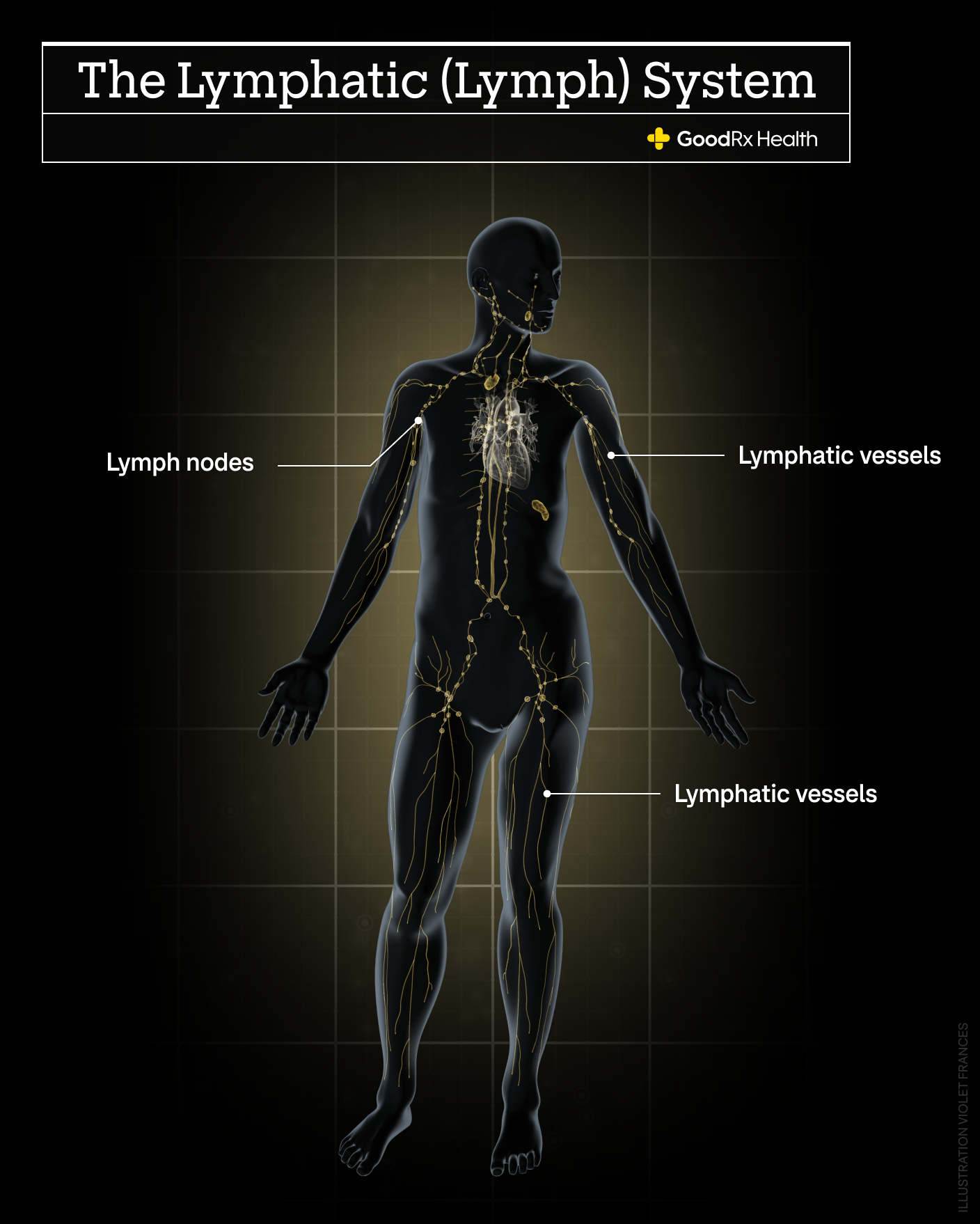Key takeaways:
Lymphoma is a cancer that affects different cells that make up the immune system. There are two main types — Hodgkin and non-Hodgkin lymphoma.
Hodgkin lymphoma affects a specific type of cell called a “B cell.” It most commonly occurs in people between the ages 20 and 40. Treatment usually involves chemotherapy and radiation.
Non-Hodgkin lymphoma includes all the other types of lymphomas. They’re categorized based on location, cell type, and how aggressive the cancer is.
Lymphomas are cancers of the lymphatic system. The lymphatic system is a network of tubes and lymph nodes throughout the body that contain lymphocytes (white blood cells) and lymph fluid. The system’s main job is to fight off infection.

There are many different types of lymphomas. But there are two main types: Hodgkin lymphoma and non-Hodgkin lymphoma. Let’s take a closer look at the differences between these types of lymphomas, including their symptoms, treatments, and outlooks.
Why are there different types of lymphoma?
Lymphomas develop when certain cells in your immune system (lymphocytes) rapidly divide and grow out of control. There are different types of lymphocytes that each have a different job, like T cells and B cells. Cancer can develop in any of these cells, which leads to a different type of lymphoma.
Hodgkin lymphoma and non-Hodgkin lymphoma affect different cell types. And to make matters a little more confusing, non-Hodgkin lymphoma is not just one kind of lymphoma. It’s a term that includes many different kinds of lymphoma.
Hodgkin lymphoma
Hodgkin lymphoma is named after Dr. Thomas Hodgkin. It develops when B cells in the immune system mutate (change) into cancerous cells. These cancerous cells are called Reed-Sternberg cells, after the scientist who first identified them under a microscope. These cells gather in lymph nodes and cause swelling.
Non-Hodgkin lymphoma
Non-Hodgkin lymphoma includes all the other types of lymphoma. There are many different ways to classify non-Hodgkin lymphoma — from which cells are involved to how aggressive they are.
Non-Hodgkin lymphoma can also occur in other areas of the body outside the lymphatic system — like the stomach or the spleen. And each type of lymphoma can be very different.
Is non-Hodgkin lymphoma more aggressive?
Unfortunately, there’s not a straightforward answer to this question. That’s because non-Hodgkin lymphoma is a collection of so many different types of cancers. And each type varies in terms of how aggressive it is.
Read more like this
Explore these related articles, suggested for readers like you.
In general, the survival rate for Hodgkin lymphoma is slightly higher than the survival rate for non-Hodgkin lymphoma. But since there’s a wide range, it really comes down to each individual case.
What are the main differences between non-Hodgkin and Hodgkin lymphoma?
Since different types of lymphoma affect different cells, this also means the cancers behave differently. And one of the biggest differences is the treatment for each one.
When someone is first diagnosed with lymphoma, they will usually have a biopsy (of an involved lymph node) to figure out exactly what type of lymphoma they have. But below are some of the general differences between Hodgkin and non-Hodgkin lymphoma.
Who they affect
Hodgkin lymphoma can affect anyone. But it most commonly occurs in people ages 20 to 40 years old.
The chances of developing non-Hodgkin lymphoma, on the other hand, increases the older you get. A third of non-Hodgkin lymphoma cases are diagnosed in people over the age of 75.
Symptoms
The symptoms of both Hodgkin and non-Hodgkin lymphoma are essentially the same. The most common symptom of either lymphoma is swelling of one of the lymph nodes — like in the neck, armpit, or groin. Usually it is not painful.
Other symptoms of any type of lymphoma include:
Night sweats
Fever
Fatigue
Unintentional weight loss
Chest pain or shortness of breath
Itchy skin and/or rash
Treatment
Hodgkin lymphoma is almost always treated with chemotherapy. These are medications that kill the rapidly dividing cancer cells. Oftentimes, radiation therapy is used as well. Radiation treatment kills cancer cells with high-energy beams that are directed at tumors. Hodgkin lymphoma is rarely treated with surgery.
Treatment for non-Hodgkin lymphoma depends on the specific subtype.
For small, less-aggressive cases, watchful waiting is recommended. For bigger or more aggressive non-Hodgkin lymphoma, treatment options can include chemotherapy and radiation.
CAR-T cell therapy and immunotherapy are newer options to treat non-Hodgkin lymphoma. These are very dependent on the specific type of cancer and cell type. CAR-T cell therapy removes T cells from the body, changes them in the lab, and then puts them back inside the body. In the lab, scientists are able to train them to attack the lymphoma cells. Immunotherapy refers to medications that help someone’s own immune system fight the cancer.
Similar to Hodgkin lymphoma, surgery is not usually a treatment option for non-Hodgkin lymphoma.
Survival
Survival after treatment for lymphoma varies a lot from cancer to cancer and person to person. In general, the chances of being alive 5 years after diagnosis is 88% for Hodgkin lymphoma and 73% for non-Hodgkin lymphoma.
Keep in mind that survival statistics for general populations — like people with lymphoma — often are less relevant for individuals.
The bottom line
Lymphomas are a group of cancers that affect the cells of the immune system. There are many different kinds. They’re categorized based on tumor cell type, location, and how aggressive they are. A biopsy is needed to identify what type of lymphoma someone has. And the treatment and survival depends on these results. In general, lymphoma is a very treatable and survivable condition.

Why trust our experts?


References
American Cancer Society. (2018). What is Hodgkin lymphoma?
American Cancer Society. (2018). What is non-Hodgkin lymphoma?
American Cancer Society. (2019). Immunotherapy.
American Cancer Society. (2022). CAR T-cell therapy and its side effects.
Lymphoma Research Foundation. (2022). Understanding survivorship: When treatment is over.
MedlinePlus. (2022). Lymph system.
The Leukemia & Lymphoma Society. (2022). Chimeric antigen receptor (CAR) T-cell therapy.
The Leukemia & Lymphoma Society. (2022). Hodgkin lymphoma.
The Leukemia & Lymphoma Society. (2022). Non-Hodgkin lymphoma.
U.K. National Health Service. (2021). Hodgkin lymphoma.
U.K. National Health Service. (2022). Non-Hodgkin lymphoma.


















